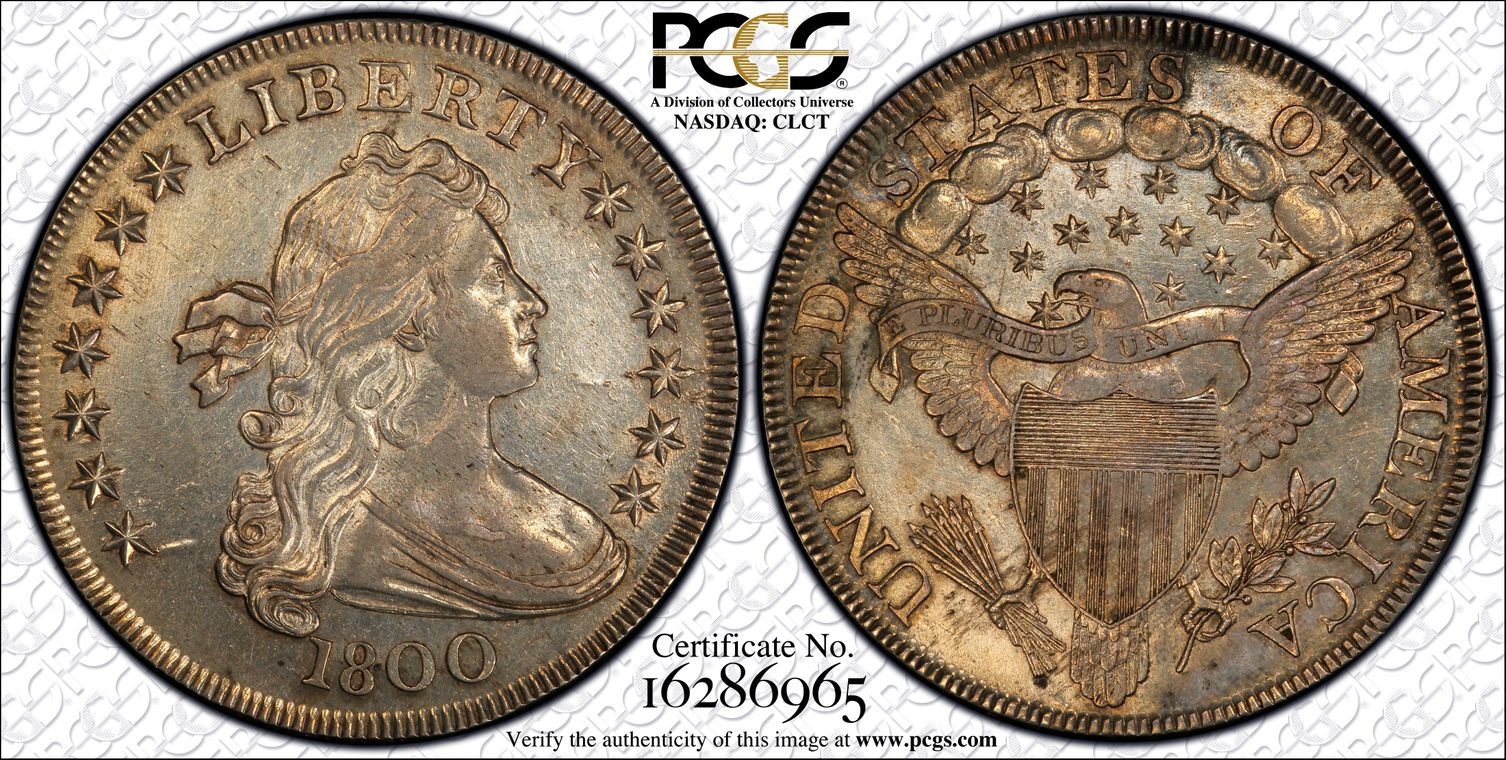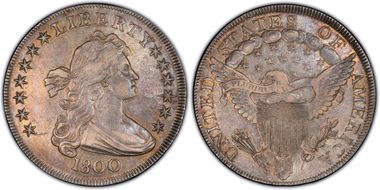1800 $1 BB-181 AU55 认证号16286965, PCGS号40067
拥有者评论
B-1,BB-181. 180 close in date. A scarce date and very rare in EF and above. This is a high CC within top 2. Beautiful golden toning with excellent strike unlike most with typical weak central strikes. Strike and luster alone makes this specimen an AU58! Est.Pop.90-150 coins. R5
专家评论
Q. David Bowers
The following narrative, with minor editing, is from my "Silver Dollars & Trade Dollars of the United States: A Complete Encyclopedia" (Wolfeboro, NH: Bowers and Merena Galleries, Inc., 1993). Note: the Notable Specimens list should be used with caution - it has been updated in my 2013 edition of "The Encyclopedia of United States Silver Dollars 1794-1804."B-1, H-1
OBVERSE 1: 180 close in date. TY too far apart. The 1 in date barely misses touching the hair. Slight elevation in field between lowest left stat and' hair due to depression in die. Die flaws near inside point of star 11 and also at lower outside of same star. Star 8 near Y, and star 13 near bust, the two about equidistant. On the left, stars 3 and 4 are closer together than are any others. Point of star 11 closest to border has its end bent upward, a most unusual characteristic.
Obverse die. used to strike 1800 BB-181 only.
REVERSE A: Leaf touches lower right corner of serif of I in AMERICA (compare to reverse of BB-'183, which touches bottom of I at a different point). Point of star touches point of lower part of eagle's beak. A in AMERICA touches only 3rd feather. First T in STATES is double-punched. AME joined at lower part. A over clouds 2 and 3. Tip of arrowhead under center of U in UNITED.
Reverse die used to strike 1800 BB-181 (earlier use) and BB-182 (later use).
DIE STATES:
Die State I: Perfect dies.
COLLECTING NOTES: This is one of the scarcer varieties of the year. I estimate that 90 to 160 exist in all grades combined.
The literature shows a confusing difference of opinion concerning rarity. In his 1881 Type-Table J.W. Haseltine simply noted it as being "scarce." In 1950, M.H. Bolender felt differently, and stated this: "My records over a period of 40 years show it to be extremely rare." Today in the early 1990s, it is felt that the population is somewhere in the range of 90 to 160 coins, an estimate which is large enough to provide a specimen for most advanced specialists seeking one.
Most examples are in lower grades, with VG and Fine being quite acceptable for the variety. VF coins are very rare, and any piece over VF, such as the Spies EF, would be a sure-fire Condition Census item. All seen are lightly struck at the centers.
NOTABLE SPECIMENS:
European Specimen. MS-60. New Netherlands 48th Sale, T. James Clarke Collection, 1956:639. "Full Mint State. Highly lustrous and without visible signs of wear. A very few light and insignificant nicks. Originally discovered in Europe, currently the property of a New York dealer."
Merkin Specimen. EF-40 Lester Merkin, June 1972:294. "EF, considerable mint lustre and iridescence; some areas suggest Unc., others weaker. Planchet defect (start of a split), at final O. Unimportant bagmarks."
Spies Specimen. EF-40 Stack's, W. Earl Spies Collection, 1974:172. "Die flaws are bold and now extend from the chin through the 11th star to edge. The 'bar' at the first star is bold. EF with considerable frosty lustre."
Brooks Specimen. VF-35. Bowers and Merena Galleries, Brooks Collection, 1989:252. "VF-35. An attractive example having a faint nuance of pleasing heather coloration. The surfaces are as smooth as one might expect to see on examples in the EF range. The obverse die of this variety can be immediately recognized by the presence of a bulge by the first star."
Davis Specimen. VF-30 Stack's, Davis-Graves (James Davis) Collection, 1954:1311. "Minor edge bruise under bust point; some lustre and wear. VF to EF."
Baldenhofer Specimen. VF-30. W. G. Baldenhofer to Stack's, Farish-Baldcnhofer Sale, 1955. A.J. Ostheimer, 3rd Collection. Superior Galleries, ANA Convention Sale, 1975:970. "Die flaw at first star. VF-30, bright, obviously cleaned at one time, and now acquiring a delicate tone. Not perfectly centered, but clean and fairly attractive."
March Sale Specimen. VF-30. Stack's, March Sale, 1985:1232. "Dash-like die crack at the first star. A strong VF, nearly EF."
Boyd Specimen. VF-20. Numismatic Gallery, World's Greatest Collection, F.C.C. Boyd, 1945:88. "VF."
Taylor Specimen. VF-20. Bowers and Merena Galleries, Frederick Taylor Collection, 1987:785. "VF-20 or better. Some original mint lustre still survives. From the standpoint of actual wear the piece is probably EF or finer, but the striking is such that certain of the central details are lost, giving the piece the value of VF."
PCGS #
40067
设计师
Robert Scot
边缘
Lettered: HUNDRED CENTS ONE DOLLAR OR UNIT
直径
40.00 毫米
重量
27.00 克
铸币数量
220920
金属成分
90% Silver, 10% Copper
更高评级数量
0
评级较低的钱币数量
17
地区
The United States of America
价格指南
PCGS 数量报告
拍卖 - PCGS 评级的
拍卖 - NGC 评级的

























